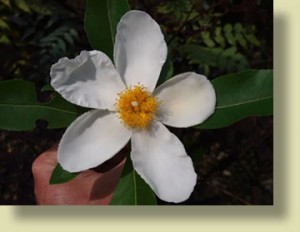‘Sweet Tea’ resulted from crossing franklinia (F. alatamaha) and loblolly bay or gordonia (G. lasianthus). Sweet Tea is still abit finicky like franklinia, but is more resistant to Phytophthora disease (soil pathogen). This new intergeneric cross possesses huge (5 inch diameter), showy flowers that look like big fried eggs. Sweet tea exhibits semi-evergreen foliage with large, single, camellia-like flowers from July through September.
Why name it ‘Sweet Tea’? It’s a member of the tea family (Theaceae). The flowers have a light sweet fragrance. Both parent species originate from the South where sweet tea runs in our veins. Sweet tea must be planted a good well-drained soil with even moisture year-round. It grows best in full sun or a little afternoon shade. Irrigation during summer dry spells is a must. Roots readily from stem cuttings, then takes off growing. Mature height is estimated to be 20-30 feet. Winter hardiness is likely in USDA zones 7 thru 10. The plant is not patented or trademarked.
Photo credit and article info. from Dr. Tom Ranney, NCSU Plant Breeder, Mountain Crops Research and Extension Center, Fletcher, NC.


 Posted in
Posted in 
